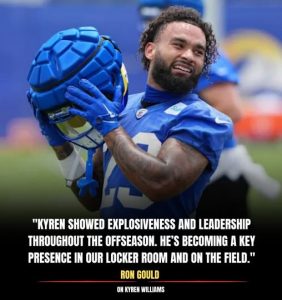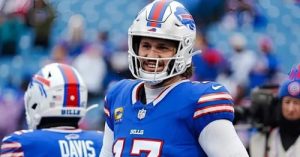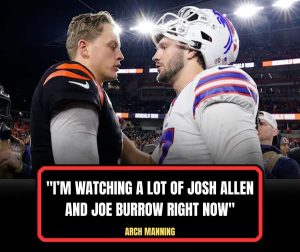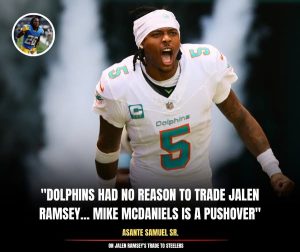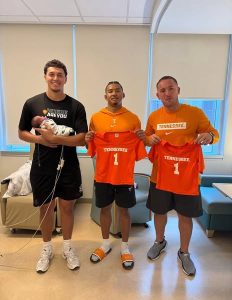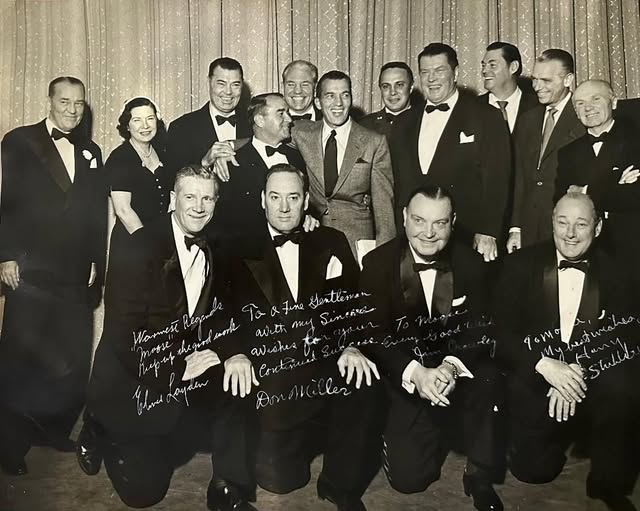
On Sunday, October 31, 1954, millions of Americans gathered around their television sets to watch one of the most remarkable tribute shows of its era on the famed Ed Sullivan program, “Toast of the Town.” This particular episode was no ordinary variety show — it was a heartfelt homage to the late Grantland Rice, the legendary sports writer whose poetic prose and colorful storytelling elevated American sports journalism to an art form.
The tribute was a dazzling convergence of talent from across the entertainment and sports world, featuring iconic performers and legendary athletes. Among the most notable guests on stage was the legendary quartet known as the Four Horsemen, the famed Notre Dame backfield whose names have been etched into college football history forever. Alongside them stood a veritable pantheon of athletic legends and entertainment luminaries, all united to honor a man whose words had transcended sport and culture alike.
A Night to Remember on ‘Toast of the Town’
Hosted by the charismatic Ed Sullivan, whose variety show was a mainstay of American television, the episode promised an unforgettable evening. According to a New York Age newspaper article dated October 30, 1954, the guest list included not only the Four Horsemen but also Nat “King” Cole, the world-renowned jazz singer and pianist; Andrés Segovia, the virtuoso classical guitarist whose influence on the instrument was unmatched; and actor Douglas Fairbanks Jr., a Hollywood star with a storied career and a deep appreciation for sports culture.
Fairbanks Jr. had a special role in the tribute: he read one of Grantland Rice’s most beloved poems, weaving Rice’s timeless words into the evening’s tapestry of memories. His dramatic recitation brought to life the spirit of Rice’s writing, reminding the audience of the poetic soul behind the sports headlines.
The Legendary Four Horsemen Take Center Stage
The Four Horsemen—Harry Stuhldreher, Don Miller, Jim Crowley, and Elmer Layden—were more than just football players; they were cultural icons. Their dominance on the gridiron at Notre Dame during the 1920s had helped elevate college football to national prominence. Grantland Rice famously dubbed them the “Four Horsemen of Notre Dame,” likening their fearsome prowess to the biblical Four Horsemen of the Apocalypse — a nickname that stuck and became part of sports lore.
In 1954, the Four Horsemen remained symbols of an era when football was played with grit, honor, and unyielding determination. Their presence on the Ed Sullivan stage was a bridge between the golden age of sports and the modern television era, connecting audiences with a storied past.
On that October night, the Four Horsemen were seated prominently in the front row for a group photo that captured a moment of sporting and cultural history. Each member personalized their signature on the photo with messages to Ed “Moose” Krause, the Notre Dame Athletic Director at the time and the recipient of this treasured memento.
A Gathering of Sporting Greats
Behind the Four Horsemen stood a constellation of other sports legends whose names resonate through time. Tennis legend Vincent Richards, a former Olympic gold medalist and World No. 1 player, lent his presence to the gathering. Beside him was Mrs. Babe Ruth—Claire Ruth—widow of the baseball icon whose legacy had defined America’s pastime.
Former heavyweight champions Jack Dempsey and Gene Tunney, both giants of the boxing world, stood side by side. Dempsey, known for his aggressive fighting style and knockout power, and Tunney, renowned for his technical skill and intelligence in the ring, symbolized the golden age of heavyweight boxing.
Golf’s legendary Gene Sarazen, who had won seven major championships and was credited with popularizing the “sand wedge,” was also in attendance. Olympic gold medalist Eddie Eagan, a unique athlete who won gold medals in both summer and winter games (boxing and bobsledding), stood proudly among his peers.
Ed Sullivan himself, the master of ceremonies, was front and center, orchestrating a show that blended entertainment with heartfelt tribute. Football star Doc Blanchard, known as “Mr. Inside” for his powerful running style at Army, was present alongside actor Douglas Fairbanks Jr., who, beyond his recitation, represented Hollywood’s enduring fascination with sports heroes.
Adding to this mix was Tarzan actor and five-time Olympic gold medalist Johnny Weissmuller, a man whose swimming prowess had set new standards and whose cinematic career had captivated audiences worldwide. Finally, jockey legend Earl Sande, whose riding skills had dominated American horse racing in the 1920s, rounded out the assembly.
This extraordinary gathering was a testament to the lasting impact of Grantland Rice’s work. He had chronicled many of these athletes’ careers and helped shape public perceptions of sport, not merely as competition but as a dramatic narrative filled with heroes, struggles, and triumphs.
The Enduring Legacy of Grantland Rice
Grantland Rice was more than a sports writer; he was a cultural figure who elevated sports storytelling to new heights. His poetic style and ability to capture the drama of the game made him one of the most influential journalists of the early 20th century. His words shaped the mythology of American sports and inspired countless athletes and fans.
Rice’s most famous line, written after the 1924 Notre Dame victory over Army, immortalized the Four Horsemen: “Outlined against a blue-gray October sky, the Four Horsemen rode again.” This vivid imagery transcended mere reporting, turning a football game into a legend.
Rice’s death in 1954 left a void in the sports world, but the outpouring of respect and admiration evident on the Ed Sullivan show that October night proved that his legacy would live on. Through performances, readings, and personal testimonials, the program celebrated not only Rice’s contributions but also the timeless spirit of sportsmanship and storytelling.
The Photo That Captured an Era
The group photo taken that evening remains a historical treasure. In the front row, the Four Horsemen’s dignified presence anchors a scene filled with icons from multiple sports disciplines. Behind them, the mixture of athletes, entertainers, and sports officials creates a vivid tableau of mid-20th century American sports culture.
Each signature and personal message on the photo adds a layer of personal connection and tribute to Notre Dame Athletic Director Ed “Moose” Krause, highlighting the close-knit relationships among these sports legends.
Impact and Reflection
The October 31, 1954, Ed Sullivan show was more than a tribute; it was a cultural event that brought together multiple generations of athletes and fans. It highlighted the unique role sports play in American identity, blending entertainment, history, and storytelling.
For viewers, it was a rare chance to witness firsthand the legends who had shaped sports in the first half of the century. For historians and fans today, it remains a snapshot of an era when athletes were revered not just for their skill but for their embodiment of ideals like courage, determination, and grace under pressure.
